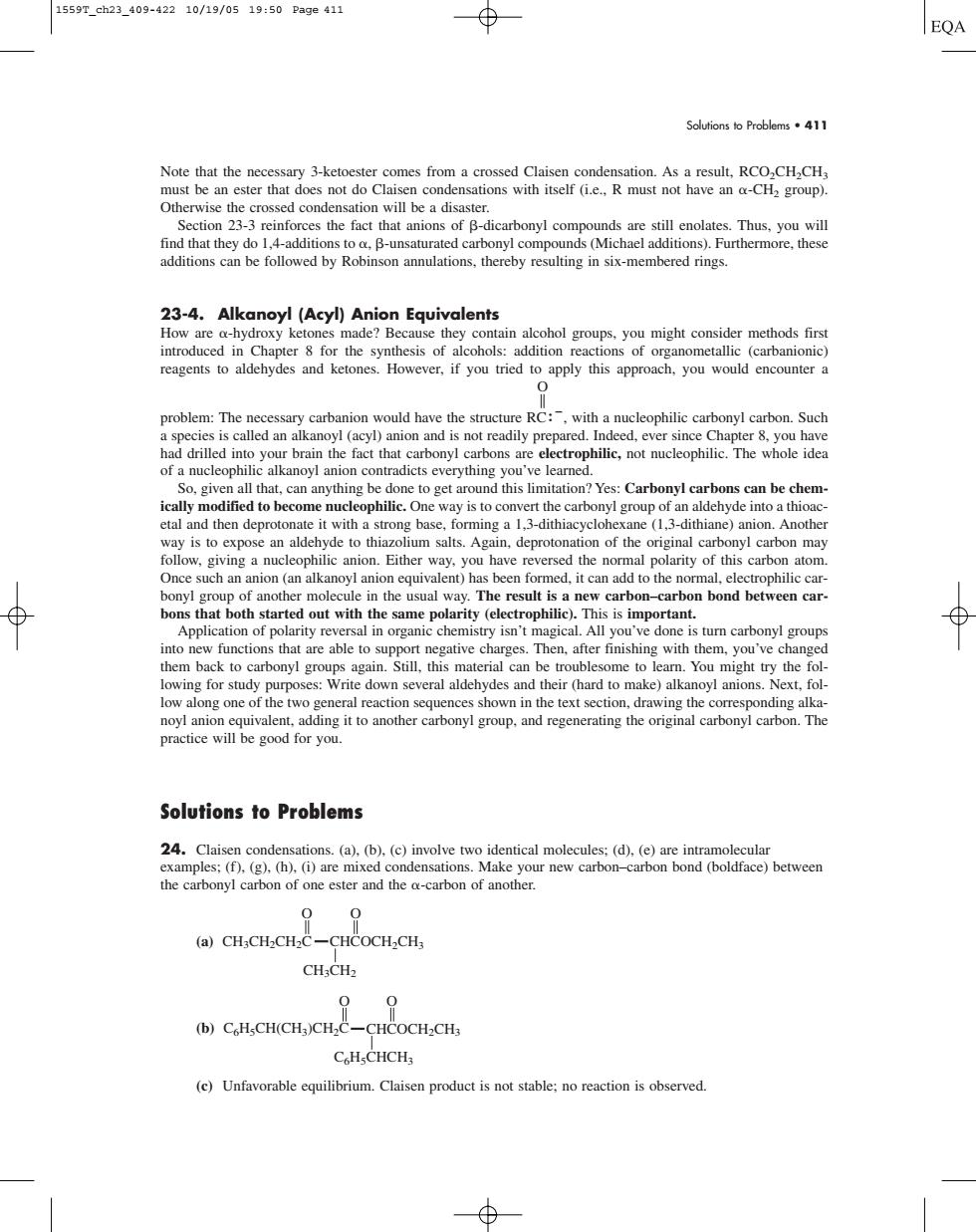正在加载图片...

1559T_ch23_409-42210/19/0519:50Pa9e411 ⊕ EQA Solutions to Problems.411 Note that the ne 3-ketoeste ondensation.as a result.RCo.CH CH en cone crossed cond he be a dis on will additions can be followed by Robinson annulations.thereby resulting in six-membered rings. 23-4.Alkanoyl(Acyl)Anion Equivalents roxy keto made'? Because th f 0 of a nucleophilic alkanoyl anion contradicts everything you've leamed s to ne (1.3-dithiane)anion.Anothe way is to expose an aldehyde to thiaz lum salts.Again,deprotona on of th nginal carb nyl carbon may nthe usual way.The result is anew carbon-carbon bond between car. All you've done carbonyl groups into new functions that ae able tosuppor negative charges.Then.after finishing with them. ng for to ca be (hard t me ke)alk low along one of the two Solutions to Problems 24.Claisen condensations.(a).(b).(c)involve two identical molecules:(d).(e)are intramolecular cm(()(h)() 0 (a)CH.CHCH2C -CHCOCH2CH CH;CH2 P 0 (b)CHCH(CH)CH C-CHCOCH-CH; CH CHCH (e)Unfavorable equilibrium.Claisen product is not stable:no reaction is observed. Solutions to Problems • 411 Note that the necessary 3-ketoester comes from a crossed Claisen condensation. As a result, RCO2CH2CH3 must be an ester that does not do Claisen condensations with itself (i.e., R must not have an -CH2 group). Otherwise the crossed condensation will be a disaster. Section 23-3 reinforces the fact that anions of -dicarbonyl compounds are still enolates. Thus, you will find that they do 1,4-additions to , -unsaturated carbonyl compounds (Michael additions). Furthermore, these additions can be followed by Robinson annulations, thereby resulting in six-membered rings. 23-4. Alkanoyl (Acyl) Anion Equivalents How are -hydroxy ketones made? Because they contain alcohol groups, you might consider methods first introduced in Chapter 8 for the synthesis of alcohols: addition reactions of organometallic (carbanionic) reagents to aldehydes and ketones. However, if you tried to apply this approach, you would encounter a O B problem: The necessary carbanion would have the structure RC), with a nucleophilic carbonyl carbon. Such a species is called an alkanoyl (acyl) anion and is not readily prepared. Indeed, ever since Chapter 8, you have had drilled into your brain the fact that carbonyl carbons are electrophilic, not nucleophilic. The whole idea of a nucleophilic alkanoyl anion contradicts everything you’ve learned. So, given all that, can anything be done to get around this limitation? Yes: Carbonyl carbons can be chemically modified to become nucleophilic. One way is to convert the carbonyl group of an aldehyde into a thioacetal and then deprotonate it with a strong base, forming a 1,3-dithiacyclohexane (1,3-dithiane) anion. Another way is to expose an aldehyde to thiazolium salts. Again, deprotonation of the original carbonyl carbon may follow, giving a nucleophilic anion. Either way, you have reversed the normal polarity of this carbon atom. Once such an anion (an alkanoyl anion equivalent) has been formed, it can add to the normal, electrophilic carbonyl group of another molecule in the usual way. The result is a new carbon–carbon bond between carbons that both started out with the same polarity (electrophilic). This is important. Application of polarity reversal in organic chemistry isn’t magical. All you’ve done is turn carbonyl groups into new functions that are able to support negative charges. Then, after finishing with them, you’ve changed them back to carbonyl groups again. Still, this material can be troublesome to learn. You might try the following for study purposes: Write down several aldehydes and their (hard to make) alkanoyl anions. Next, follow along one of the two general reaction sequences shown in the text section, drawing the corresponding alkanoyl anion equivalent, adding it to another carbonyl group, and regenerating the original carbonyl carbon. The practice will be good for you. Solutions to Problems 24. Claisen condensations. (a), (b), (c) involve two identical molecules; (d), (e) are intramolecular examples; (f), (g), (h), (i) are mixed condensations. Make your new carbon–carbon bond (boldface) between the carbonyl carbon of one ester and the -carbon of another. (a) (b) (c) Unfavorable equilibrium. Claisen product is not stable; no reaction is observed. CHCOCH2CH3 C6H5CHCH3 O O C6H5CH(CH3)CH2C CHCOCH2CH3 CH3CH2 CH3CH2CH2C O O 1559T_ch23_409-422 10/19/05 19:50 Page 411����